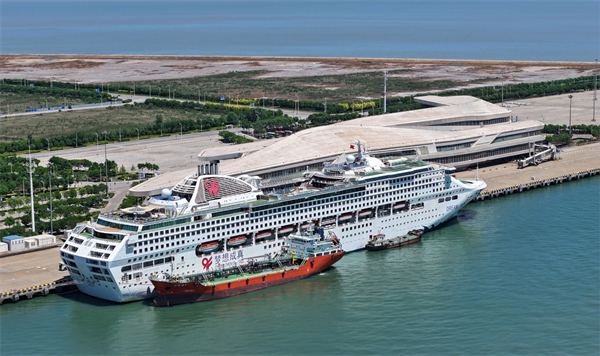New measures assist growth of cruise sector
Policy to improve docking, resupplying of international ships at Chinese ports

An aerial drone photo taken on May 15, 2024 shows the cruise ship Dream berthing at Tianjin International Cruise Home Port in North China's Tianjin municipality. [Photo/Xinhua]
New regulations to take effect on June 1 will assist the docking and resupply of international cruise ships at China's ports, officials said at a news conference in Beijing on Wednesday.
The regulations clarify the requirements for resupply activities, supply channels and regulatory systems for materials such as medicines, medical devices and duty-free tobacco products, customs facilitation measures and the legal obligations of various business entities.
Wang Zhenjiang, vice-minister of justice, said the Chinese government has promoted the development of the cruise economy. The first large, domestically built cruise ship, Adora Magic City, successfully embarked on its maiden commercial voyage on Jan 1 this year.
However, during preparations for its launch, unclear policies and inadequate support measures, among other issues, led to difficulties in supplying ship materials, exposing certain institutional bottlenecks and shortcomings in China's system for docking and resupplying international cruise ships, he said.
"These issues necessitate national legislative innovations to improve institutional norms and establish a long-term mechanism to promote the healthy and high-quality development of the cruise economy," he said.
The new regulations focus on addressing bottlenecks in the resupply process, he said, adding that they would also lay the foundation for the formulation and implementation of legal systems regarding the cruise economy.
Liu Yang, an official from the Department of Port Control of the General Administration of Customs, said that the customs department is allowing companies to submit electronic data to customs to handle the declaration of cruise ships and the addition of materials, facilitating docking and resupply operations.
Export tax refunds will also be available for resupply materials. Those sourced from abroad, unless otherwise specified, will not be subject to tariff quotas or license management, reducing customs clearance costs, she said.
Liu noted that enterprises can now use the window for international trade to streamline customs procedures for supplying food, retail items, hotel supplies, entertainment props and other necessities.
"Customs will also actively facilitate relevant enterprises in providing convenient conditions for the warehousing, distribution, transshipment, delivery and handling of resupply materials for international cruise ships docking at Chinese ports," she said.
Huo Fupeng, an official from the Department of Industry of the National Development and Reform Commission, said that the cruise market is rapidly recovering, along with global tourism, bringing China's cruise industry significant opportunities.
China's second large cruise ship entered its final assembly stage in April, and 13 cruise ports have been built in coastal cities. In addition, the resumption of inbound cruise ships is accelerating, with 21 ships operating at Chinese ports since the beginning of this year, he said.
Since the resumption of international cruises in September, annual passenger transport volume has exceeded 107,000. In the first quarter of this year, that number surpassed 190,000, showing rapid recovery, he said.
"With further improvements in the regulatory framework, China's cruise tourism market and cruise-related economy are poised for faster growth," he said.
On May 15, the National Immigration Administration announced a policy allowing visa-free entry of foreign tourist groups aboard cruise ships via all cruise ship ports along the country's coastline.

Ministry of Justice of the
People's Republic of China
All rights reserved. Presented by China Daily.
京ICP备13016994号-2


